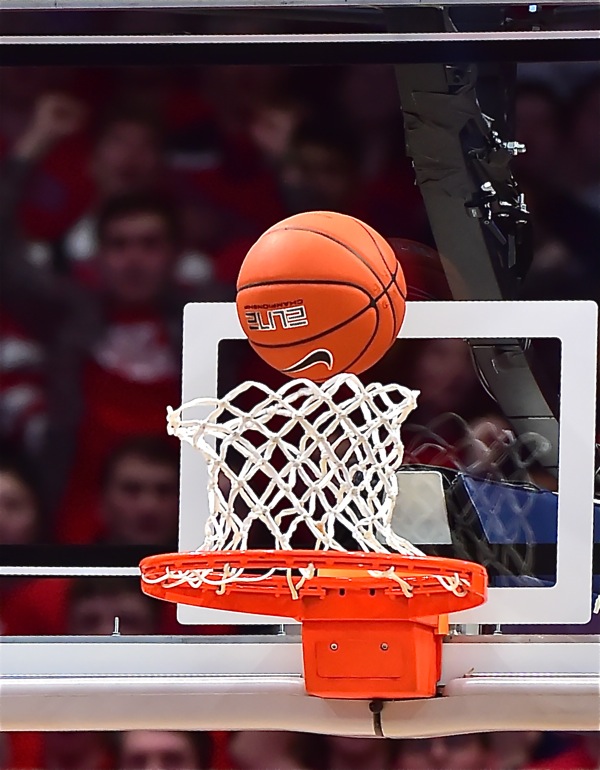
Russia’s Braylon Cordonnier in last year’s Div. IV semi-final against Richmond Heights. How do you compare to the present…and can you? (Press Pros Feature Photos)
The question of seven divisions of high school basketball becomes more obvious as the season progresses and the tournament approaches. And, are there enough athletes to make seven divisions relevant, and competitive?
 I’m sure there were some eyes opened Friday night by the margin of Division VII Delphos St. John’s 81-46 win over Division V Versailles.
I’m sure there were some eyes opened Friday night by the margin of Division VII Delphos St. John’s 81-46 win over Division V Versailles.
44-19 at halftime, St. John, for sure, is the real deal in Division VII, ranked #1 this week by Max Preps for the fact of their 15-1 record.
The same can be said for Versailles, as well, ranked #17 in Division V with a 14-4 record. The Tigers are a good basketball team.
 But here’s the question. If the best Division VII team in the state beats a top twenty Division V team in the state by 35 points…what kind of chance does the rest of Division VII have against Delphos St. John? Conventional wisdom would tell you…not much!
But here’s the question. If the best Division VII team in the state beats a top twenty Division V team in the state by 35 points…what kind of chance does the rest of Division VII have against Delphos St. John? Conventional wisdom would tell you…not much!
But these are not days of conventional wisdom, I would venture.
Because, the days of four divisions of high school basketball meant the game was obviously more competitive in each of the four divisions because of greater concentration of athletes. I’m sure the OHSAA hates to hear the phrase “watered down”, but that’s what’s being said more and more with each passing week of seven divisions of basketball.
Applying the same conventional wisdom to seven divisions, and the old question of competitive balance: How many Division VII teams in Ohio, broken out as they are now – schools that small – have enough athletes to honestly compete?
Russia, for that matter, is ranked #2 currently, and unbeaten in 17 games. I’ve seen them and they’re very good, a typical Russia team. And the Raiders play Versailles Saturday night, which will lead some people to consider the final score, regardless of who wins, and ask…what does it mean?
If Russia wins, are the Raiders that much better for the fact of having beaten a Division V team?
If Versailles wins, are the Raiders any less good, or less challenged with their schedule in the Shelby County League, despite having beaten Division IV Bellefontaine? No one gave it a second thought in the past when Russia was Division IV and Versailles was Division III – the concentration of athletes. It was just basketball. This, is a different day.
And more conventional thinking. What do you expect the competitive quality of the tournament to be this year given the question of how many good teams (by conventional standards) are there, actually, in seven divisions?
“I guess we’ll see,” said Delphos St. John coach Aaron Elwer Friday night. “But this is what’s been handed to us and this is the first year for it. I’ll probably have a better answer for you here in a couple of months. But we know there are going to be some lopsided games come tournament time. There’s just no way around it. That’s where we are in the state, and that’s the way it’s going to be.”
 What a tremendous answer! Because Aaron Elwer, one of the best basketball coaches in the state of Ohio, has about as much idea of what to expect as those who sit and ponder questions like this that have no answers. I wanted to hug him for taking me off the hook.
What a tremendous answer! Because Aaron Elwer, one of the best basketball coaches in the state of Ohio, has about as much idea of what to expect as those who sit and ponder questions like this that have no answers. I wanted to hug him for taking me off the hook.
“I try not to worry too much about it,” he said. “We’ll try to control what we can and take care of business the way that we know.”
Except…will you really know what you need to know, when it comes time to know?
“My observation is this,” said another area coach this week. “I worry that we’re approaching a point where we’ll have some very good teams, and some bad teams, and nothing in the middle. And when that day comes, who are the very good teams going to play, and how will you know how good you really are? No one thought about it in this way. They just made the argument for seven division creating more championship opportunities for the other, less competitive schools.”

Publisher Sonny Fulks writes OHSAA sports and the Buckeyes for Press Pros Magazine.
To his point, by season’s end I will have seen about 60 basketball games. And every week someone asks, “Who’s the best team you’ve seen?”
My stock answer: I’m not sure. It’s just different.
And if you scoff, consider…that among the fourteen boys games I’ve seen so far, the cumulative made free throw percentage of the twenty eight teams is barely 60%.
And does that mean anything, anymore?
I honestly don’t know.
I just know what it used to mean.


